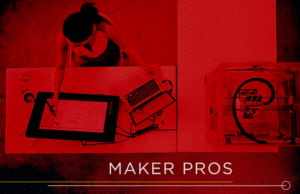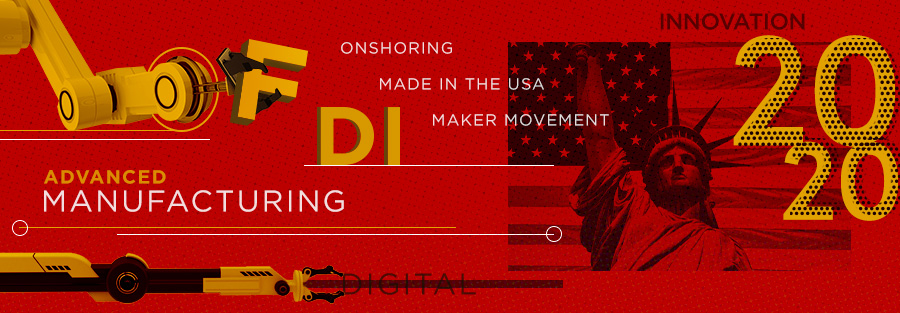Making in America
How tech startups are compelling and enabling offshoring reversal
For members of the electronics industry, dealing with disruption is just another day at the office. Every so often, however, established tech companies face Disruption (think of it like capital-L Law vs. lowercase-l law). This is where many multinationals find themselves today. Ironically enough, it is the very source of this Disruption that may well save these enterprises from being marginalized or outright supplanted.

Let’s take a step back and set the stage. Over the past several years, a new breed of startups has emerged. These highly tech-savvy individuals, often referred to as maker pros, are leveraging digital tools and other advanced technologies such as 3D printing, machine learning, crowdsourcing, cloud-based collaboration and analytics, to develop products that satisfy customer demands for unique, personal items, and they are doing so in a way that neither the wholesale nor retail communities have been able to, explained Andrew Postal, managing partner of MMG Advisors.
As a result, businesses across all industry sectors, B2C and B2B, are trying to figure out how to reimagine their supply lines to handle more quick turn, customized products, while reducing their reliance on inventory, said Postal. This means replacing the mass production, offshoring paradigm they have relied on for the past decade or two, with a more regional, even hyperlocal, model deploying advanced “factory of the future” technologies including additive manufacturing, automation, machine learning and robotics to achieve “mass customization.”
“Businesses across all industry sectors are trying to figure out how to reimagine their supply lines to handle more quick turn, customized products.”
Caveat Emptor

“Locating production closer to the point of consumption in the Americas allows companies to avoid the expense and risk of long global supply chains, and be more responsive to customers’ increasing demand for more personalized products,” said Hal Sirkin, senior partner, managing director, Boston Consulting Group.
Despite these benefits, the revival of manufacturing activity in North America has been a surprisingly controversial topic, engendering fears of anti-globalization and protectionism. It should be noted, however, that growth in North American manufacturing activity is being propelled more by foreign direct investments (FDI) than by repatriation, said Harry Moser, founder of the Reshoring Initiative. In fact, data from the U.S. Department of Commerce shows FDI in the U.S. manufacturing sector increased an average of nine percent annually between 2011 and 2015, and in 2015, FDI in the United States reached a record $348 billion.
The distinction is important because demonstrates that there is more to this movement than U.S.-based organizations posturing for favorable publicity. At its core, the movement is all about economics, said Simon Ellis, program vice president, supply chain strategies, IDC. “Companies that are transferring production to North America aren’t doing it out of the goodness of their hearts,” he said. “They are in the business of making money so, if it is financially advantageous to bring manufacturing here, they will do it.”
As favorable as the economics may appear, many multinational manufacturers have discovered that transitioning from production from Asia to the Western hemisphere isn’t quite as simple as sending out change of address notices. Decades of offshore outsourcing have caused the once robust supply chain infrastructure of the West to atrophy, Sirkin asserted.
“Decades of offshore outsourcing have caused the once robust supply chain infrastructure of the West to atrophy.”
“This is a crucial part of the story people tend to miss. When manufacturer ‘A’ announces plans to bring operations to the U.S., everyone thinks it’s this great win,” Ellis said. “But, they may quickly find that the capabilities they need to produce and market their products here are no longer sufficient.” (Click here to read the unique strategy athletic wear maker Nike deployed to solve this infrastructure challenge.)
Making in America
So, what’s an OEM to do? In order to compete against these disruptive innovators they need a regional presence, but they can’t shift manufacturing without local resources capable of supporting innovation. As it happens, reviving manufacturing in America may well depend on those “making” in America. Leveraging the momentum of the maker movement and booming technology startup community will help bring manufacturing back to the region, said Sirkin. “There is this groundswell of innovation from these communities that pushes companies to be smarter and think more competitively so they can produce more.”
“Reviving manufacturing in America may well depend on those ‘making’ in America.”
Without the constraints of shareholder expectations and corporate bureaucracy, entrepreneurial makers and startups have had the freedom to experiment, take risks, fail, learn and try again. The maker movement is “awakening the sleeping giant” – big, established corporations that have become increasingly more conservative, said Hackster.io Co-founder Adam Benzion. “Makers are doing things with products that even the original manufacturers never considered. Look at a company like Oculus. In 2012, they started hacking in their garage with open source tools. They got resourced through crowdfunding and in 2014 they were acquired by Facebook for over $2B.”
Us and Them
Rather than viewing these startups as a threat, today’s forward-looking enterprises recognize it is better to having these disruptors as allies than as competitors, said Jeremiah Owyang, founder, Crowd Companies. “There is a new dynamic in the economy in the U.S. and within the supply chain. It’s time to get past ‘us vs. them.’”
Owyang cited Johnson & Johnson’s JLABS as a prime example of a traditional company embracing this new dynamic. J&J rents space to startups, encouraging them to create new products. “Some may be competitive, but J&J is okay with that because they would rather have the ecosystem in-house than on the outside.” When you combine the innovative potential of makers with the corporate ability to scale, “you have a very powerful engine,” Owyang said. “That is where the magic is.”
“When you combine the innovative potential of makers with the corporate ability to scale, you have a very powerful engine. That is where the magic is.”
Mega-brands like General Electric (GE) and Proctor and Gamble (P&G) have also recognized the wisdom of harnessing the collective genius of the crowd to incubate new ideas and technologies with less cost or risk to their businesses. P&G, for example, has stated that it expects a third of its new products to come from outside the organization, IDC’s Ellis related. Essentially, the plan, he explained, is to find people who have interesting products and “do the Godfather thing and ‘make them an offer they cannot refuse.’”
Believing that incremental progress is a “formula for extinction,” GE says open innovation is “not just an initiative, but a fundamental shift in the way the company does business.” Through programs like GENIUSLINK™, GE is crowdsourcing innovation, both internally and externally. In 2016, GE partnered with Hackster.io to conduct a “Lights for Life” design challenge. From a pool of nearly 1000 entries, GE chose a winning design and is now taking the product to market, Benzion explained. “When you reach out to the crowd for ideas and get things like the GE bulb, you are changing the ideation equation financially. Having all these other people thinking outside the box on your behalf is a real game changer.”
Everyone Wins
With open-source hardware platforms such as Arduino, mbed and Raspberry Pi; and resources like hackerspaces/makerspaces, crowdfunding and affordable 3D printing, there is no doubt that it is easier than ever for makers to pursue their passion, but it is still far from easy, said Benzion. “Only about 10 percent will successfully scale their business and commercialize their design.”
“When you reach out to the crowd for ideas and get things like the GE bulb, you are changing the ideation equation financially.”
As makers, Bob Merriman, co-founder of Force Impact Technologies, and his partner Anthony Gonzales have first-hand experience with the challenges of building a business from scratch. Merriman and Gonzales created the FITGuard smart mouth guard, impact detection and analysis platform designed to help athletes avoid injury from concussions by measuring the force of an impact. Merriman is part of Avnet’s MakerSource team.
“When the maker movement started, it was more about personal gratification and social validation, putting projects online and have people tell you how cool they are. These people never intended to take it any further,” Merriman said. As a result, there is a lot of energy and excitement in these communities, but many “don’t even know what they don’t know about how to get their product made.”
Entrepreneurial makers can improve their odds of successfully moving from start-up to “scale-up” – a company that has validated its product in a market and proven its economics are sustainable – by leveraging the market knowledge, resources, supply chain experience and visibility of large established firms. The white paper, “Winning Together,” from U.K. innovation foundation NESTA, outlines some of the most common programs corporate employ to engage with startups. These include business support, partnerships, sharing resources, investments, acquisitions and “one-off” events like Hackathons.
“The process of making is the process of learning. The more makers you have, the more advanced the society will be both economically and technologically.”
Big OEMs, with bulging bank accounts and long-standing brand recognition, should not underestimate the disruptive potential of these rising stars, said Merriman. “Research indicates that by the year 2022, 75 percent of all IoT innovation will come from startups – companies with fewer than 20 employees,” he explained. USA Today reported in 2014 that each year makers are responsible for infusing as much as $29 billion into the world economy.
“The process of making is the process of learning,” Benzion concluded. “The more makers you have in a society, the more advanced the society will be both economically and technologically.” In other words, the rising tide lifts all boats. If established organizations want to reap the benefits of disruptive innovation, they need to align themselves with disruptive innovators.
Related Resources:
- Report: The State of Startup/Corporate Collaboration, 2016
- Article: A Framework for Deep-Tech Collaboration
- Perspective: Honing US Manufacturing’s Competitive Edge
- Tool: Reshoring Initiative TCO Estimator
- Report: Winning Together: A Guide to Successful Corporate–Startup Collaborations
- Report: Scaling Up: Overcoming Barriers in Corporate-Startup Collaboration
- Blog: Brooklyn Factory Helps Target & Sears Transition to Onshoring
- Benchmark Tool: Open Organization Test
